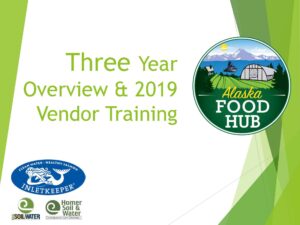There are several various data points collected by food hubs. Be sure to pick what’s meaningful to your mission, values, customers, and vendors, and that you can maintain regularly and accurately.
Here is a list of some data points to consider:
- number of customers (by location)
- number of vendors (by location)
- number of partners
- type of vendors (ex. farmers, value-added, fishers, non-food)
- number of partnerships
- number/ variety of products
- overall sales
- sales by location
- sales growth over time
- food access/ donation program statistics
Here is a great example of data and operation assessment: ALASKA FOOD HUB PRESENTATION

Through convening the Alaska Food Hubs Working Group, it was recommended to compile a statewide report and participate in some collective strategic planning, to develop food system levers that could move the food system in a more positive direction of growth and equity in the different regions and statewide. Some initiatives included in the discussion are:
- amount of food traded between hubs
- amount of food donated or discounted (for food access programs/ low-income customers)
- variety of food access programs (ex. WIC, SNAP)
Be sure to share your data with customers, partners, vendors, and with other food hubs in your region… As the saying goes, “The rising tide floats all boats.” Remember when possible, to collaborate with other food hubs in your state or region to provide statewide reporting. This can lead to increased funding opportunities for food hubs, inclusion in food access programs, and overall awareness of the benefits (and even the existence) of food hubs in Alaska.